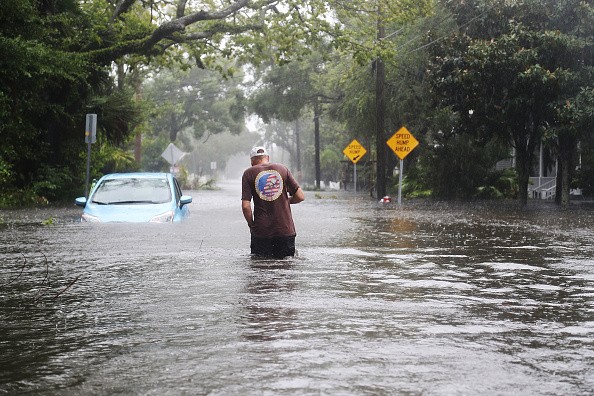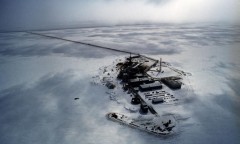By Iesha Javed, | October 09, 2016

A man walks through a flooded street as Hurricane Matthew passes through the area in St Augustine, Florida.
The biggest storm in this century, Hurricane Matthew, caused widespread devastation across Haiti before moving on to Georgia and South Carolina. Local authorities are still on high alert, and people are in a state of fear and panic.
The hurricane killed almost 900 people and dislodged tens of thousands in Haiti before it crashed against the coast near the edge of Georgia and South Carolina early Saturday.
Like Us on Facebook
Heavy gusts beat Tybee Island in Georgia and Hilton Head just over the boundary in South Carolina. The National Weather Service estimates a record tide level of more than 12 feet at the entrance of the Savannah River, which borders both states.
After devastating Florida, causing major flooding, 1 million power outages, and six deaths, Matthew turned northward on Saturday. Just off the southeast U.S. coast, it brought torrential rain, mighty winds, a 9-foot potential storm surge and the possibility of catastrophic flooding to two more states in the US.
According to Florida officials, two people were killed by collapsing trees even though the most powerful winds lingered just offshore. An elderly couple also died of carbon monoxide poisoning from a generator while hiding from the hurricane inside a garage.
The number of deaths in Haiti, the worst hit in the Americas, towered as Matthew rampaged through its western peninsula on Tuesday. Information lines remained cut off in remote areas due to the storm with winds speeding at 145 mph (233 kph) and torrential rain. Some 61,500 people were in shelters, officials said, after the storm flung the sea into waterfront settlements.
The National Hurricane Center last traced Matthew heading north at 12 mph with the center of the storm just off the shore, carrying maximum sustained winds of 105 mph.
The NHC lowered Matthew to a Category 2 hurricane on Friday, but forecasters have predicted a combination of a dangerous storm surge and 15 inches of maximum rainfall, which can cause deadly flooding.
The National Weather Service reported nearly 17 inches of precipitation at Hunter U.S. Army Airfield in Savannah, Georgia over a 48-hour time span.
-
Use of Coronavirus Pandemic Drones Raises Privacy Concerns: Drones Spread Fear, Local Officials Say

-
Coronavirus Hampers The Delivery Of Lockheed Martin F-35 Stealth Fighters For 2020

-
Instagram Speeds Up Plans to Add Account Memorialization Feature Due to COVID-19 Deaths

-
NASA: Perseverance Plans to Bring 'Mars Rock' to Earth in 2031

-
600 Dead And 3,000 In The Hospital as Iranians Believed Drinking High-Concentrations of Alcohol Can Cure The Coronavirus

-
600 Dead And 3,000 In The Hospital as Iranians Believed Drinking High-Concentrations of Alcohol Can Cure The Coronavirus

-
COVID-19: Doctors, Nurses Use Virtual Reality to Learn New Skills in Treating Coronavirus Patients













